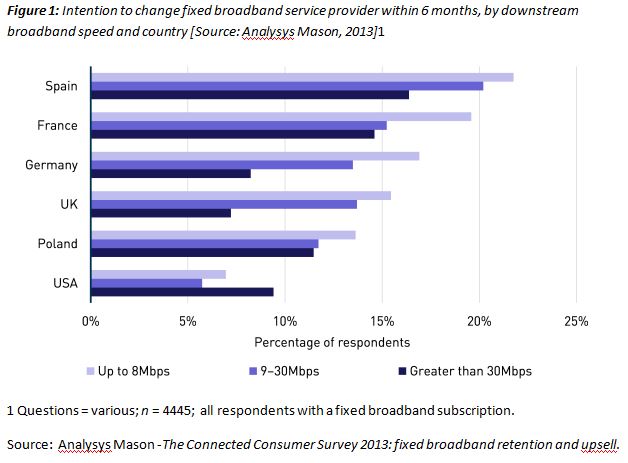Internationally respected research firm Analysys Mason is out with its Connected Consumer 2013 Survey, and the chief finding is a message to service providers; fixed line superfast broadband customers are more satisfied with their service than average customers and by three percentage points are less likely to churn. In short, the message is, “Accelerate superfast broadband deployment.”
The proof of fixed broadband’s desirability is in the numbers
Analysys Mason asked 6,610 consumers in Europe and the U.S. what one thing they will look for in their next fixed broadband service. Not surprisingly, most said they wanted “a cheaper service”. However, 14 percent of respondents contemplating leaving their current provider in the next six months said the reason was because their current service was not fast enough.
Doing the numbers, the researchers found that if a typical operator had a monthly churn rate of 1.4 percent, the impact of upgrading those customers to higher speeds could reduce this to 1.2 percent per month – the equivalent of a 3-percent annual increase in the customer base. They further noted that, “By comparison, this is around twice the annual subscriber growth rate of major European operators such as Deutsche Telekom or Telefónica in their domestic markets, and comparable to that of Orange in France.”
This relationship between speeds and retention is shown in the chart below.

Figure 1: Intention to change fixed broadband service provider within 6 months, by downstream broadband speed and country [Source: Analysys Mason, 2013]1
1 Questions = various; n = 4445; all respondents with a fixed broadband subscription.
Source: Analysys Mason -The Connected Consumer Survey 2013: fixed broadband retention and upsell.
And the trend was consistent across Europe although not quite as true in the U.S.
Superfast price premium appears to be less important to take-up than absolute price and availability
The report also found that higher-speed customers are more satisfied and less likely to churn than their peers with lower-speed services. And, the authors believe this suggests that some customers would like higher speeds – possibly because they believe that higher speeds would make them more satisfied.
While much of this is what might be expected, but the survey did have one rather interesting find. It turned out that price elasticity did not seem to matter as there was no discernible relationship between the price premium on superfast services and take-up in the survey countries. This led to the observations that the reason for this lack of a relationship was the caused by:
- The availability of higher-speed services is limited in geographical terms (for example, the footprint of superfast broadband is restricted)
- Price competition for non-superfast broadband drives the price down, so the superfast price premium can be high but still affordable for consumers
- Superfast is driven by both operator and demand-side factors.
The conclusions drawn from these findings were that while the ability to generate incremental revenue from superfast broadband varies by country, price premiums will be difficult to sustain. Indeed, the authors say higher speeds will primarily work as a customer retention strategy. They recommend, “Operators could, and should, make more of value-added services as part of superfast offers.”
The bottom line is that while superfast broadband is an attraction, and a way to get customers whose contracts are coming up for renewal with a service provider with an inferior offer when it comes to feeds and speeds, at the end of the day there must be something more. So along with accelerating superfast deployment the services agenda, including such things as the integration of things like Wi-Fi and cellular connectivity and partnerships with premium content providers must go hand in glove with the rollout at the risk that the next time one of your contracts comes up for review customers will find possibly a host of other reasons to consider their options. Fast pipes that are only used for access are only a temporary quick fix.
Edited by
Rachel Ramsey